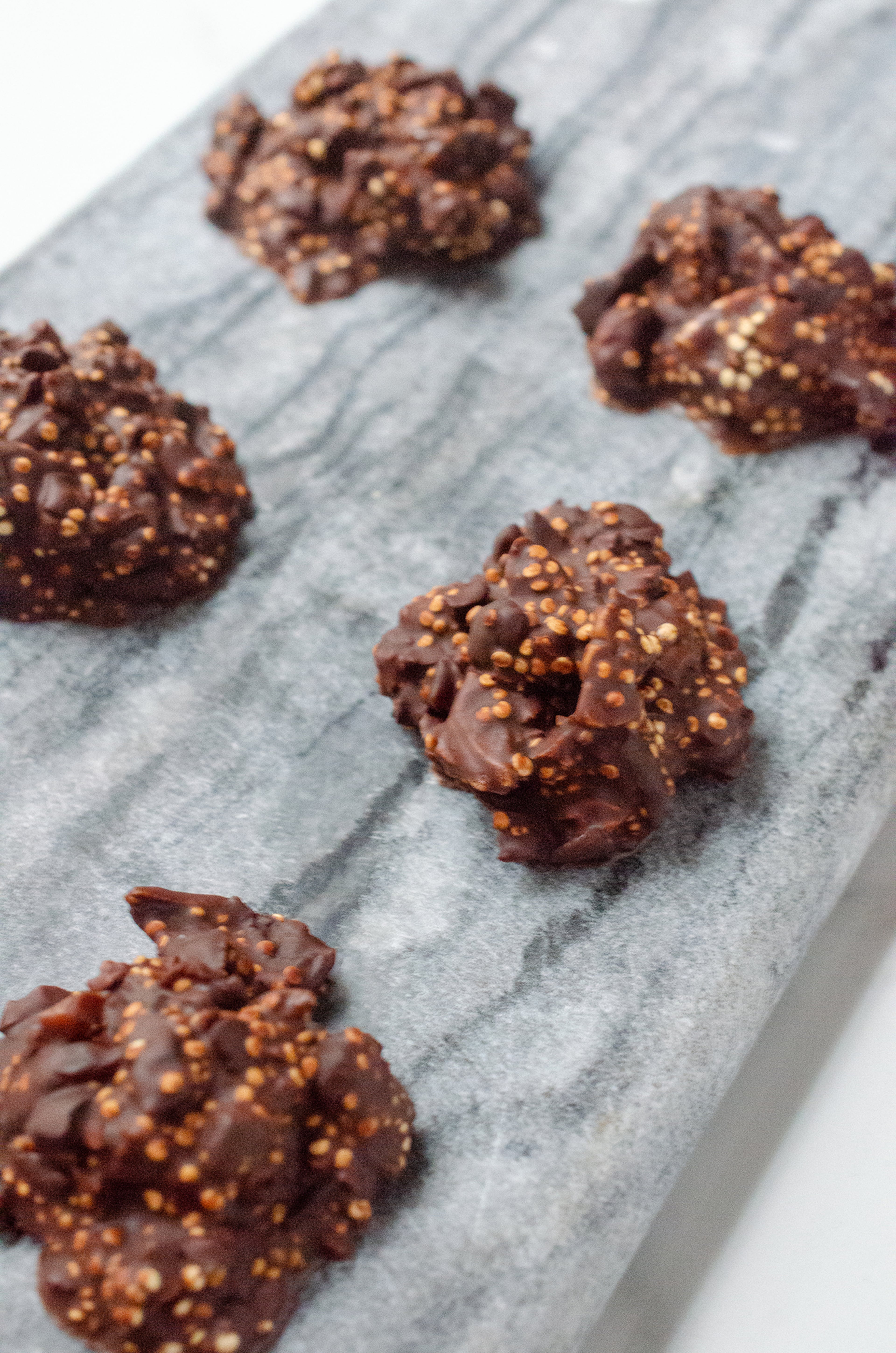RECIPES: You can love chocolate (and your heart, too)

February is all about hearts, love and gifting over-the-top boxes of indulgent chocolate confections. What about flipping that script to show your own heart some love? And yes, it can still include chocolate. I recently read an article from Johns Hopkins that discussed the benefits of dark chocolate and was inspired to make three delicious desserts. You know, in the name of good health.
How can something associated with pleasure, hedonism and indulgence have anything to do with better health? To understand where chocolate comes from and why it makes us feel as good as it tastes, let’s talk about how chocolate is produced.
Chocolate is made from the bean (also known as the seed) of the cacao tree, whose scientific name is Theobroma cacao. Theobroma is Latin for “food of the gods.” Cacao is the primary ingredient in dark chocolate. Cacao is packed with antioxidants, magnesium, calcium, zinc, copper and selenium. It contains more antioxidants per gram than blueberries, acai berries and pomegranates! And as any chocolate lover will tell you, cacao also triggers serotonin and dopamine, neurotransmitters that are associated with elevating mood and mental well-being.
Cacao trees grow in the tropics around the equator. Cacao pods are brightly colored in shades of vivid orange, bright yellow, rich burgundy and deep red that grow directly out of the tree, not off of a branch like an orange or an apple. These colorful pods are harvested by hand and then carefully broken open to release the cacao beans, which are embedded in a moist, fibrous white pulp.
The beans are then set aside to ferment in their own juices for six to 10 days. Fermentation allows the bitter, fairly tasteless cacao to develop the rich flavors associated with chocolate. Once the beans have been fermented, they are laid out to dry. The dried beans are cleaned and roasted at low temperatures to further develop flavor. (Roasting also prepares the beans for the removal of the shell to extract the interior nib.) The taste of cacao nibs is bittersweet with the crunchy, toasty flavor of roasted nuts and is as close to eating pure cacao as you can get. (Think of cacao as the raw, unprocessed version of cocoa.)
The nibs are then finely ground and liquefied, resulting in what is called “chocolate liquor,” a mixture of cacao solids and cocoa butter — chocolate in its purest form. Pure chocolate liquor is very dark and bitter. Chocolate liquor may be hardened in molds to form baking chocolate, pressed to reduce the naturally occurring cocoa butter and then pulverized to make cocoa powder, or mixed with sugar and additional cocoa butter to make chocolate candy.
You will often see a percentage printed on the outside of a chocolate bar or bag of chocolate chips. In general, the higher the percentage, the more cacao and the less sugar, dairy, emulsifiers or other flavorings. This is the key to heart-healthy chocolate. The higher the percentage, the greater the access to the health benefits of chocolate.
RECIPES
As you prepare for Valentine’s Day, show your loved one some real love with heart-healthy dark chocolate. Mocha Bittersweet Chocolate Pudding, Chocolate Peanut Powder Dipping Sauce and Quinoa Superfood Truffles are certain to satisfy and satiate.

Mocha Bittersweet Chocolate Pudding
Pudding is often thought to be for kids, but it’s one of my favorite make-ahead desserts and I often serve it at adult dinner parties. This recipe is super-easy to prepare, lower in fat and sugar than many recipes and brimming with dark chocolate flavor. It’s a sweet treat you can feel good about loving.
- 4 tablespoons turbinado sugar
- 3 tablespoons cornstarch
- 1 1/2 tablespoons cocoa powder
- 1 tablespoon instant espresso powder
- 2 1/2 cups 2% milk
- Pinch of fine sea salt
- 1 teaspoon pure vanilla extract
- 1 cup (6 ounces) 72% cocoa bittersweet chocolate chips
- Whisk together the sugar, cornstarch, cocoa powder and espresso powder in a medium, heavy saucepan. Gradually whisk in milk. Place the saucepan over medium-high heat and bring mixture to a boil, whisking constantly. Reduce heat to medium and simmer 1 minute or until thick.
- Remove from heat; add salt, vanilla and chocolate chips, stirring until melted and mixture is smooth. Let cool slightly, whisking constantly to prevent lumps.
- Pour 1/2 cup pudding into 6 (6-ounce) ramekins. To prevent a skin from forming, cover each ramekin with a piece of plastic wrap flush to the surface of the pudding. Transfer to the refrigerator and chill until set, at least 1 hour.
Nutritional information
Per serving: Per serving: 265 calories (percent of calories from fat, 53), 8 grams protein, 26 grams carbohydrates, 14 grams total sugars, 5 grams fiber, 17 grams total fat (11 grams saturated), 9 milligrams cholesterol, 80 milligrams sodium.
Chocolate Peanut Powder Dipping Sauce
Traditional chocolate ganache is a mixture of chopped chocolate and heavy cream and makes the most amazing fondue-style dipping sauce for fruit, berries, cake, cookies, marshmallows and nuts. And it’s a fat bomb right at 100 calories a tablespoon. This easy recipe redo makes a rich, dark dipping sauce that is lower in calories and fat.
- 4 tablespoons dark chocolate cocoa powder
- 4 tablespoons peanut powder
- 9 tablespoons lukewarm water
- Combine cocoa, peanut powder and water. Stir to combine. Serve with fruit such as strawberries, sliced apples or bananas. Store in a sealable container in the refrigerator, up to 3 days.
Nutritional information
Per serving: Per tablespoon: 14 calories (percent of calories from fat, 26), 1 gram protein, 2 grams carbohydrates, trace total sugars, 1 gram fiber, trace total fat (no saturated fat), no cholesterol, 16 milligrams sodium.
Quinoa Superfood Truffles
Truffles are usually made from chocolate and fat-laden heavy cream. These truffles are made of bits of good and good for you nuts, berries and cacao nibs held together with even more dark chocolate. The surprise ingredient is quinoa, a whole grain packed with nutrients, fiber and protein. Quinoa gives our truffles a crispy texture and bumps up the nutritional value even more.
1/2 cup uncooked, unrinsed quinoa
1 cup 72% cocoa bittersweet chocolate chips
1 tablespoon coconut oil
1/2 cup cacao nibs
1/2 cup chopped pecans
1/2 cup lightly sweetened dried cranberries
Line a baking sheet with parchment paper or a nonstick silicone baking sheet. Set aside.
Heat quinoa in a dry saucepan over medium heat until toasted and some of the grains have popped, about 3 minutes. Add bittersweet chocolate chips and coconut oil. Stir until melted and combined. Add cacao nibs, chopped pecans and lightly sweetened cranberries. Stir until well combined. (It’s going to look gritty!) Using a tablespoon, scoop the mixture onto the prepared baking sheet and chill until firm, about 1 hour. Store in the refrigerator up to 5 days.
Makes about 30.
Per truffle: 59 calories (percent of calories from fat, 51), 1 gram protein, 7 grams carbohydrates, 4 grams total sugars, 1 gram fiber, 3 grams total fat (1 gram saturated), no cholesterol, trace sodium.
- 1/2 cup uncooked, unrinsed quinoa
- 1 cup 72% cocoa bittersweet chocolate chips
- 1 tablespoon coconut oil
- 1/2 cup cacao nibs
- 1/2 cup chopped pecans
- 1/2 cup lightly sweetened dried cranberries
- Line a baking sheet with parchment paper or a nonstick silicone baking sheet. Set aside.
- Heat quinoa in a dry saucepan over medium heat until toasted and some of the grains have popped, about 3 minutes. Add bittersweet chocolate chips and coconut oil. Stir until melted and combined. Add cacao nibs, chopped pecans and lightly sweetened cranberries. Stir until well combined. (It’s going to look gritty!) Using a tablespoon, scoop the mixture onto the prepared baking sheet and chill until firm, about 1 hour. Store in the refrigerator up to 5 days.
Nutritional information
Per serving: Per truffle: 59 calories (percent of calories from fat, 51), 1 gram protein, 7 grams carbohydrates, 4 grams total sugars, 1 gram fiber, 3 grams total fat (1 gram saturated), no cholesterol, trace sodium.Sign up for the AJC Food and Dining Newsletter
Read more stories like this by liking Atlanta Restaurant Scene on Facebook, following @ATLDiningNews on Twitter and @ajcdining on Instagram.

